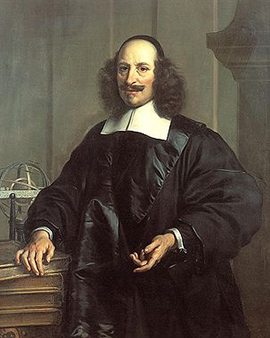Joan or Johannes Blaeu was born in the city of Alkmar in the Netherlands. When he was seven years old, the family moved to Amsterdam. His father, Willem Jansoon Blaeu, a pupil of Tycho Brahe, was a cartographer and engraver who specialized in the production of globes and atlases. The young Blaeu later also embarked on this career. Nothing is known about his youth and his education. One only knows that he became a doctor of law at the age of only 24 years. However, he does not seem to have worked as a lawyer, but to have been active in his father's business. When Ala died in 1638, his sons Joan and Cornelis took over his father's company and Joan Blaeu became the managing director and officially appointed cartographer of the Dutch East India Company. In 1940 he published the first three volumes of the world-famous Novus Atlas "theatrum orbis terrarum sive" and in 1645 and 1654 further supplementary volumes followed. The Novus Atlas with its beautifully coloured copper engraved maps established the international fame of Johannes Blaeu.
Shortly afterwards, the publisher and artist began an even more ambitious project, the Atlas Major. The large eleven-volume edition contained almost 600 maps of the entire world known at that time. In addition there were about 3000 pages of text with descriptions of the different countries. Every single map was provided with a richly decorated cartouche and with drawings of allegorical figures. Depending on what the customers wanted, the sheets, which were actually printed in black and white, were also hand-coloured, gilded and lavishly bound in parchment or leather. It was even possible to purchase specially made bookcases for them. The Atlas Major was the cartographic masterpiece of the Renaissance and very precious and correspondingly expensive. It was one of the most expensive publications at that time. Today it is a very rare antiquarian rarity. Besides the Novum Atlas and the Atlas Major, Johannes Blaeu also published many city maps, mainly of the Netherlands as well as Belgium and Luxembourg, which belonged to the Netherlands at that time. In 1672 a devastating fire destroyed Johannes Blaeu's factory and the entire Spanish language edition of the Atala Major. He never recovered from this severe blow and died the following year.
×





.jpg)
.jpg)
.jpg)
.jpg)
 - (MeisterDrucke-203592).jpg)
 - (MeisterDrucke-203592).jpg)
.jpg)
.jpg)
.jpg)
.jpg)
 from - (MeisterDrucke-259626).jpg)
 from - (MeisterDrucke-259626).jpg)
.jpg)
.jpg)
.jpg)
.jpg)
.jpg)
.jpg)
.jpg)
.jpg)
.jpg)
.jpg)
_-_(MeisterDrucke-1430795).jpg)
_-_(MeisterDrucke-1430795).jpg)
.jpg)
.jpg)
 - (MeisterDrucke-80672).jpg)
 - (MeisterDrucke-80672).jpg)
_Bologna_Bologna_Emilia-Romagna_Italy_cop_-_(MeisterDrucke-1110462).jpg)
_Bologna_Bologna_Emilia-Romagna_Italy_cop_-_(MeisterDrucke-1110462).jpg)
.jpg)
.jpg)
.jpg)
.jpg)
.jpg)
.jpg)
 - (MeisterDrucke-174047).jpg)
 - (MeisterDrucke-174047).jpg)
.jpg)
.jpg)
.jpg)
.jpg)
_-_(MeisterDrucke-1115258).jpg)
_-_(MeisterDrucke-1115258).jpg)
_Italy_-_(MeisterDrucke-1119308).jpg)
_Italy_-_(MeisterDrucke-1119308).jpg)
.jpg)
.jpg)
.jpg)
.jpg)
.jpg)
.jpg)
.jpg)
.jpg)
.jpg)
.jpg)
_print_from_The_-_(MeisterDrucke-1119846).jpg)
_print_from_The_-_(MeisterDrucke-1119846).jpg)
.jpg)
.jpg)
 from the Atlas Major c1630 - (MeisterDrucke-190998).jpg)
 from the Atlas Major c1630 - (MeisterDrucke-190998).jpg)
 - (MeisterDrucke-190032).jpg)
 - (MeisterDrucke-190032).jpg)
.jpg)
.jpg)
.jpg)
.jpg)
.jpg)
.jpg)
.jpg)
.jpg)
.jpg)
.jpg)
.jpg)
.jpg)
.jpg)
.jpg)
.jpg)
.jpg)
.jpg)
.jpg)
.jpg)
.jpg)
_LOC_98687202_-_(MeisterDrucke-1561707).jpg)
_LOC_98687202_-_(MeisterDrucke-1561707).jpg)
.jpg)
.jpg)
.jpg)
.jpg)
.jpg)
.jpg)
.jpg)
.jpg)
.jpg)
.jpg)
.jpg)
.jpg)
 - (MeisterDrucke-304779).jpg)
 - (MeisterDrucke-304779).jpg)
.jpg)
.jpg)
.jpg)
.jpg)
.jpg)
.jpg)
.jpg)
.jpg)
.jpg)
.jpg)
.jpg)
.jpg)
.jpg)
.jpg)
.jpg)
.jpg)
.jpg)
.jpg)
.jpg)
.jpg)
.jpg)
.jpg)
.jpg)
.jpg)
_-_(MeisterDrucke-1115167).jpg)
_-_(MeisterDrucke-1115167).jpg)
.jpg)
.jpg)
.jpg)
.jpg)
.jpg)
.jpg)
.jpg)
.jpg)
.jpg)
.jpg)
 - (MeisterDrucke-183516).jpg)
 - (MeisterDrucke-183516).jpg)
_-_(MeisterDrucke-1105885).jpg)
_-_(MeisterDrucke-1105885).jpg)
.jpg)
.jpg)
.jpg)
.jpg)
.jpg)
.jpg)
.jpg)
.jpg)
.jpg)
.jpg)
.jpg)
.jpg)
.jpg)
.jpg)
.jpg)
.jpg)
.jpg)
.jpg)
.jpg)
.jpg)
 - (MeisterDrucke-169491).jpg)
 - (MeisterDrucke-169491).jpg)
.jpg)
.jpg)
 aged 40 amongst his astronomical ins - (MeisterDrucke-302088).jpg)
 aged 40 amongst his astronomical ins - (MeisterDrucke-302088).jpg)
_in_1600_engraving_from_-_(MeisterDrucke-1093812).jpg)
_in_1600_engraving_from_-_(MeisterDrucke-1093812).jpg)
.jpg)
.jpg)
.jpg)
.jpg)
.jpg)
.jpg)
.jpg)
.jpg)
.jpg)
.jpg)
_c1600_(engr_-_(MeisterDrucke-1430796).jpg)
_c1600_(engr_-_(MeisterDrucke-1430796).jpg)
 - (MeisterDrucke-153535).jpg)
 - (MeisterDrucke-153535).jpg)
.jpg)
.jpg)
.jpg)
.jpg)
_printed_in_1686_-_(MeisterDrucke-1109224).jpg)
_printed_in_1686_-_(MeisterDrucke-1109224).jpg)
.jpg)
.jpg)
.jpg)
.jpg)
.jpg)
.jpg)
 - (MeisterDrucke-152371).jpg)
 - (MeisterDrucke-152371).jpg)
_-_(MeisterDrucke-1507995).jpg)
_-_(MeisterDrucke-1507995).jpg)
.jpg)
.jpg)






